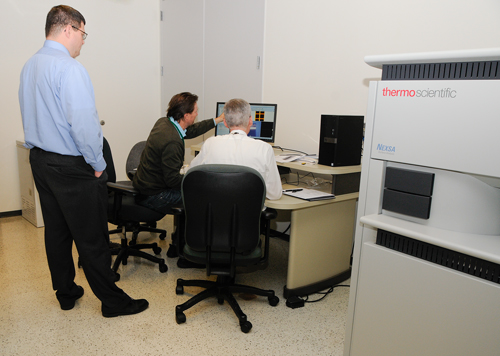Newly Acquired Nexsa XPS System Expands Surface Chemical Analysis Capability
Knowing the composition and chemical properties of the surface of a sample can be critical to understanding its behavior and answering a client’s questions. We are excited to announce the installation of our newest XPS instrument, a ThermoFisher Scientific Nexsa X-Ray Photoelectron Spectrometer, at McCrone Associates. With our new XPS, clients can anticipate high-quality information on the composition and chemistry of surfaces encompassing an expanded application space for this technique, solving problems in glass analysis, plastics, ceramics, and much more.
The Nexsa XPS features a new monochromated X-ray source design that achieves both improved sensitivity for trace elements and the capability of analyzing features smaller than 10 µm with a depth resolution on the order of nanometers. The instrument also features a dual-mode ion source which allows for sputter cleaning of insulators, such as glass or ceramics, and depth profiling of soft materials, such as polymers and organics, as well as conventional depth profiling of conductive metals. Sample charge compensation is accomplished with a single click using a dual-beam electron/ion flood source, eliminating complicated charge referencing requirements when analyzing insulating materials. Thus, surface composition, chemical state information, and high-resolution depth profiling can be accomplished for a wide variety of materials, from conductors to insulators, ranging from the hardiest ceramics to the softest polymers, using a single analytical system. The sample holder design enables analyses of fibers and powders as well as the traditional solid samples, and permits angle-resolved measurements as well.
The Nexsa X-ray Photoelectron Spectrometer is operated using the Avantage software package, which includes assistance with spectral interpretation and powerful data processing tools, including quantitative analysis, peak deconvolution, and multivariate statistical analysis of composition maps, depth profiles, and line profiles.
This high-performance XPS instrument, qualified for service in December 2018, is the first installation of a Nexsa system at a commercial service laboratory in the United States.
McCrone Associates has offered X-ray photoelectron spectroscopy (XPS), also known as electron spectroscopy for chemical analysis (ESCA), to our clients for more than 40 years, being one of the first commercial service laboratories to do so.

Comments
Daniel McLain
I frequently have clients that want to replace one material with another on their medical devices. For blood contact devices assessing thrombogenicity potential is a regulatory requirement. Material 'surface' can impact thrombogenicity potential. What would a study cost to compare the surface of the old material versus the new material?
Replies
Leslie Bolin
Thank you for reading the article, Dr. McClain. I have forwarded your question to our McCrone Associates scientists, and you should receive a reply shortly.
add comment